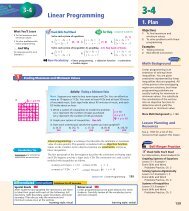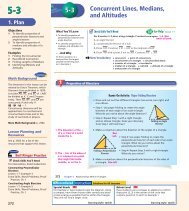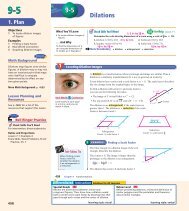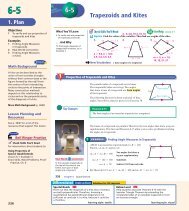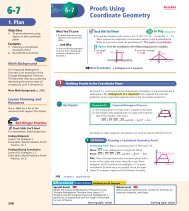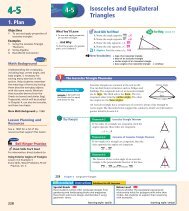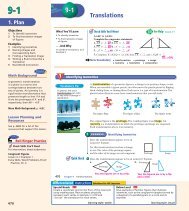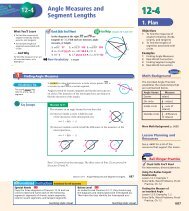Create successful ePaper yourself
Turn your PDF publications into a flip-book with our unique Google optimized e-Paper software.
Guided Instruction<br />
Tactile Learners<br />
Have students tape the sides of a<br />
sheet of paper together (without<br />
overlapping) to form a cylinder.<br />
Ask: What is the lateral area of<br />
the cylinder? the area of the<br />
paper<br />
Connection to Algebra<br />
The formula for the surface area<br />
of a cylinder is sometimes written<br />
as S.A. = 2pr(r + h). Have<br />
students show that this formula<br />
is equivalent to the formula<br />
S.A. = 2prh + 2pr 2 .<br />
4<br />
610<br />
EXAMPLE<br />
Diversity<br />
Some students may never<br />
have seen a steamroller. Have<br />
other students explain how<br />
steamrollers work.<br />
PowerPoint<br />
Additional Examples<br />
The radius of the base of a<br />
cylinder is 6 ft, and its height is<br />
9 ft. Find its surface area in terms<br />
of p. 180π ft2 3<br />
12 Finding Surface Area of a Cylinder<br />
Real-World<br />
Key Concepts Theorem 11-1 Lateral and Surface Areas of a Prism<br />
Connection<br />
A full turn of the roller inks a<br />
rectangle with area equal to<br />
the roller’s lateral area.<br />
Like a prism, a cylinder has two congruent parallel bases. However, the bases of<br />
a cylinder are circles. An altitude of a cylinder is a perpendicular segment that<br />
joins the planes of the bases. The height h of a cylinder is the length of an altitude.<br />
Bases<br />
h<br />
right cylinders<br />
oblique cylinder<br />
In this book you may assume that a cylinder is a right cylinder unless<br />
stated or pictured otherwise.<br />
To find the area of the curved surface of a cylinder, visualize “unrolling” it. The<br />
area of the resulting rectangle is the lateral area of the cylinder. The surface area<br />
of a cylinder is the sum of the lateral area and the areas of the two circular bases.<br />
You can find formulas for these areas by looking at a net for a cylinder.<br />
Key Concepts Theorem 11-2 Lateral and Surface Areas of a Cylinder<br />
610 Chapter 11 Surface Area and Volume<br />
h<br />
The lateral area of a right prism is the product of<br />
the perimeter of the base and the height.<br />
L.A. = ph<br />
The surface area of a right prism is the sum of<br />
the lateral area and the areas of the two bases.<br />
S.A. = L.A. + 2B<br />
2pr<br />
Lateral<br />
Area<br />
The lateral area of a right cylinder is the product of the<br />
circumference of the base and the height of the cylinder.<br />
L.A. = 2prh, or L.A. = pdh<br />
The surface area of a right cylinder is the sum of the lateral<br />
area and the areas of the two bases.<br />
S.A. = L.A. + 2B, or S.A. = 2prh + 2pr2 h<br />
r<br />
h<br />
Surface<br />
Area<br />
h<br />
μ<br />
r<br />
r<br />
h<br />
p is the<br />
perimeter<br />
of a base.<br />
B is the area of a base.<br />
h<br />
Area of a base<br />
B � pr 2<br />
B is the area<br />
of a base. r



